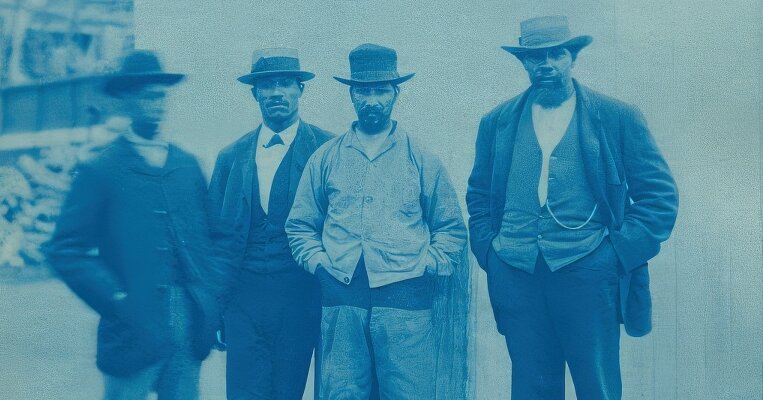BLACK IN BLUES: How a Color Tells the Story of My People, by Imani Perry
Blue is humanity’s favorite color, and no wonder. It’s everywhere: the sky, the sea that makes our earth resemble a Big Blue Marble, the internet (That Dress; “I’m looking for a man in finance/trust fund/6’5”/blue eyes”). It’s jeans and velvet and a hundred-year-old, critically contested rhapsody and William Gass’s bawdy 1976 “inquiry.”
It is also, as Imani Perry illuminates in a new book that swirls and flicks like an actual marble, a color inextricable from the Black race. Most clearly in the blues, the genre of music that evolved from spirituals and work songs and was quickly seized upon by a growing mass market, “made of sheets of sound, layered and unstable, that could make you feel much more than words,” as she writes. But in so many other realms of art and life too, often obscured from view.
Reading “Black in Blues” is like putting on a pair of those special Kodak 3-D viewfinders that make objects and issues leap suddenly into focus. Periwinkle laid on otherwise unmarked graves. The turquoise of lethal menthol cigarette packaging. The background of flags symbolizing freedoms unfairly distributed. The uniforms of Union soldiers and police officers..
Perry is a professor and author of eight other works of nonfiction, including “South to America,” a genre-bender plumbing national and personal history below the Mason-Dixon line that won the National Book Award in 2022. Though almost 200 pages shorter, “Black in Blues” ranges even more widely, from the Middle Ages, when the English called dark-skinned people “blew,” or blue; to the blue-green tiger sharks of the Middle Passage; to the toxic cobalt, mostly from Congo, that powers her computer. Its chapters are tide pools: quite short, but deep and teeming.
Whether by choice or because of deadline constraints, Perry rises above the current political fray, those blue states jutting around the red like an awkwardly fitting jigsaw puzzle. She examines the racist French philosopher Montesquieu’s scorn for West African beads, not the bracelets donned by Democratic white women in somewhat hollow solidarity after the election, nor the powdery pantsuits of Kamala Harris.
She shines new light on old familiars, like George Washington Carver, so often reduced in schoolbooks to peanut entrepreneur, who invented a highly coveted formula for Egyptian blue called Oxidation No. 9. She considers both the blue worn by one of the Little Rock Nine students and the bruises suffered by another after she was thrown down the schoolhouse stairs. We revisit Toni Morrison’s “The Bluest Eye” and Miles Davis reclaiming the Blue Period from Picasso.
Perry asserts that her work is intended to be a quilt of sorts, which is very meta. (Yikes, Facebook is also blue.) But behind such beautiful decorative art lurks a lot of ugliness. She spills much ink on indigo, the powerful pigment that came to soak the slave trade, to whose cultivation entire plantations were devoted: “Brown arms were dyed blue, sometimes permanently, like a tattoo of bondage.”
The fraught background of toile de Jouy, the printed fabric whose scenes long depicted only the white experience, has been well documented; less so that of bouclé, the looped fabric favored by Jackie Kennedy that, the author reveals, was long advertised with a racial slur likening it to Black people’s hair. She reminds us that the navy of Brooks Brothers and robin’s egg of Tiffany & Company, two leading brands of American prestige retail, both carry moral stain.
She analyzes the familiar sky blue of jasperware, the famous ceramic invented by the white abolitionist Josiah Wedgwood, subject of the 2021 biography “The Radical Potter,” but also the rarer work of Thomas Commeraw, whose identity as a formerly enslaved person was only recently uncovered.
“One of the remedies we who study Black life have pursued is diligent recovery in the face of being forgotten, obscured or submerged,” she writes. “We piece together clues and uncover hidden stories.”
There’s a biography of Commeraw out there, too, but you won’t find it cited in the pages of “Black in Blues.” Perry writes that the archive on which she draws is too large to cite, which as a fierce Footnote Franny I found one of the few frustrations of a book rightly indignant about erasure. But if you accept her premise, tucked in an aside, that history is a “term of art for document-based imperial storytelling,” the invitation to choose-your-own-research-adventure makes more sense.
The book drifts, like the ocean; it turns suddenly cloudy, like the heavens; it trills, like the jaybird (to which another chapter is devoted). It will have you looking afresh even at your corner mailbox.
BLACK IN BLUES: How a Color Tells the Story of My People | By Imani Perry | Ecco | 256 pp. | $28.99
